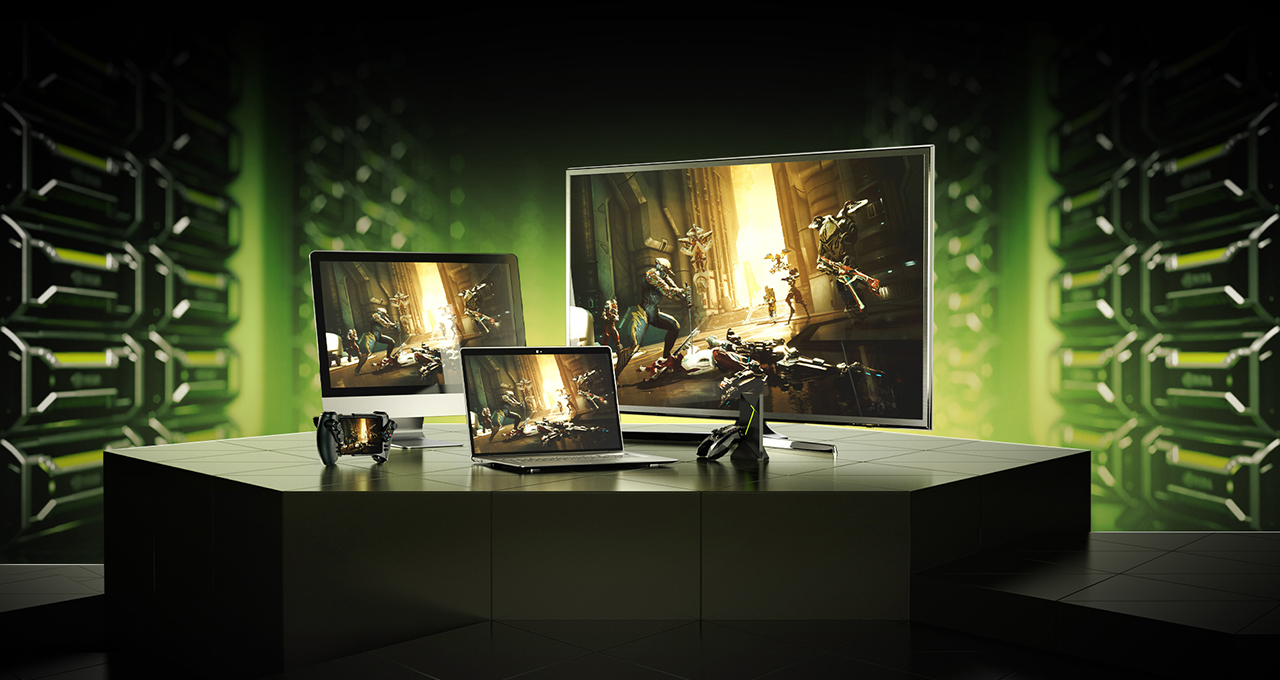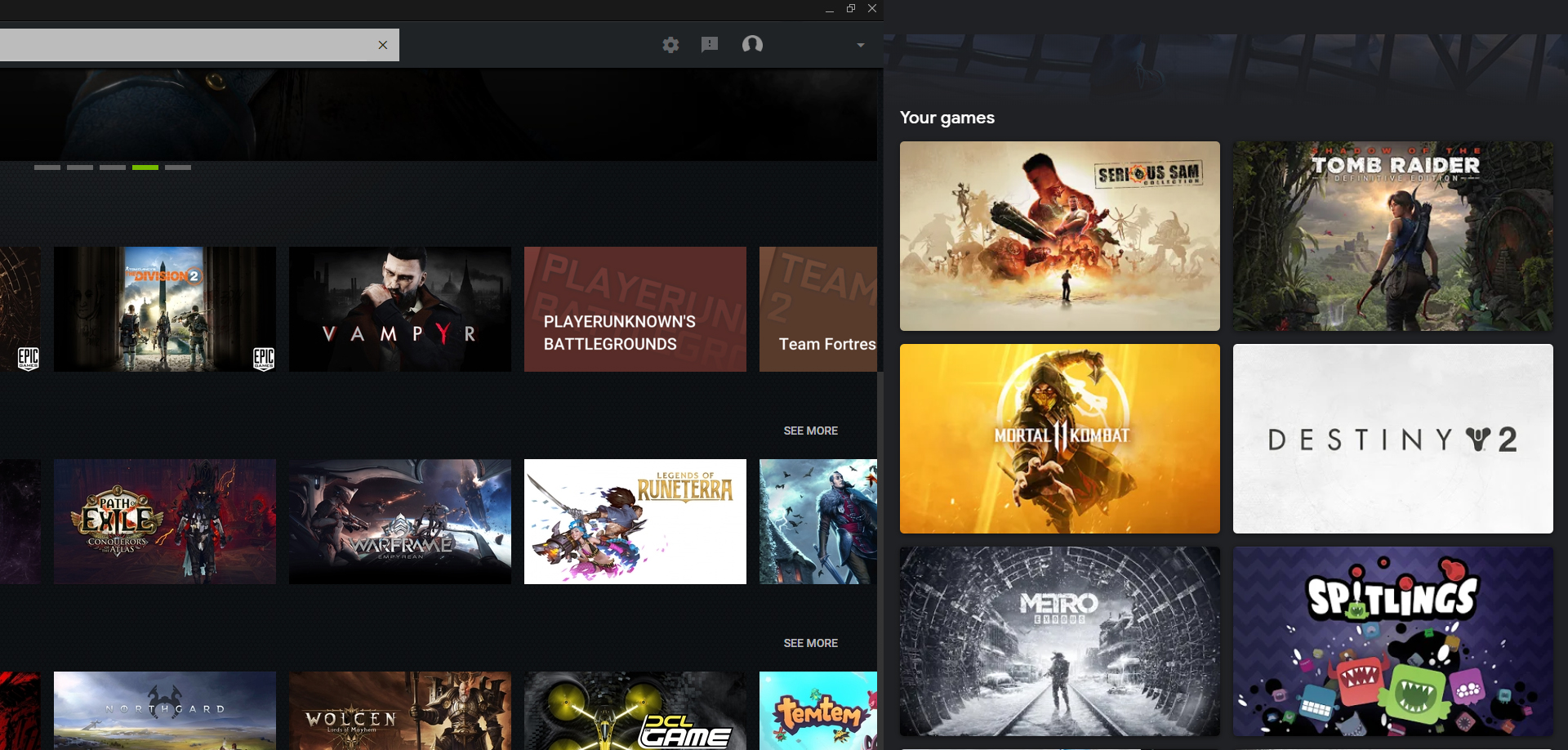GeForce Now beats Stadia in our input latency testing
It also has the preferable business model, making Stadia even less attractive.

The biggest difference between Nvidia GeForce Now and Google Stadia is the business model. Both stream games to you over the internet ('Netflix for games' is the best analogy, if not perfect), but Stadia users have to buy Stadia versions of the games they want to stream, whereas GeForce Now streams games you already own on Steam or other platforms—at least when publishers allow it to. Nvidia has run into some issues in that department.
After the issues around game ownership, the biggest concern with game streaming technology is input latency. If you're running a game on your own hardware, the amount of time it takes for a mouse click to do something on your screen depends on your PC alone. But with Stadia and GeForce now, your input is sent to a server and the result is sent back to you as a video stream, which adds many variables to the process.
Modem: Netgear CM600
Router: Asus ROG Rapture GT-AC2900
Internet: Cable, Spectrum, 400+Mbps download
Running a game locally will nearly always give you lower input latency. The exception is when you're trying to run something that's way out of your hardware's league. If you're running a game at 5 fps locally, you're only seeing a new frame once every 200 ms (vs. 16 ms at 60 fps), so Stadia might just beat you there. Otherwise, we're expecting local rendering to provide the lowest input latency, and judging these streaming services based on how close they come to matching that local experience.
In my testing, GeForce Now beats Stadia when it comes to input latency. The quality of both services will be heavily dependent on your particular network situation, and so your results may vary for one reason or another—you aren't in the same physical location as me, you have a different ISP, and so on—but my testing does show that Google's infrastructure doesn't necessarily offer the best results.

Testing Methodology
Input latency
The screens were filmed at 240 fps, and latency was measured by counting the frames between a button press and the action on screen to get the latency in milliseconds. I used the same mouse on both the desktop and laptop.
Bandwidth
Keep up to date with the most important stories and the best deals, as picked by the PC Gamer team.
I tested Stadia and GeForce Now on my 400Mbps+ connection, both over Ethernet and 5Ghz WiFi. (I left the bitrate setting in GeForce Now to 'auto,' since Stadia doesn't offer the same control.) I then limited my bandwidth to 5Mbps to see how each game and platform performed under the most extreme conditions.
Framerate
I limited the fps on all games to 60. When you customize your settings in the GeForce Now launcher, the maximum framerate is 60 fps. Google Stadia limits framerate to 60 on PC automatically. Using third-party software called Nvidia Inspector, I capped the framerate on Metro Exodus and Destiny 2 to 60 fps when running them locally.
The external framerate limiter applied to locally rendered games adds to input latency, and it may add more or less than the limiters controlling the GeForce Now and Stadia versions. We can't control every variable perfectly, and opted to keep framerates identical above all else. Don't consider the local input latency results to be the best possible results under ideal conditions—they aren't, but the difference between the local and streaming latency results is consistent.
CPU: AMD Ryzen 7 2700X
GPU: Nvidia GeForce RTX 2080 Ti
Motherboard: Asus ROG Crosshair VII Hero (Wifi)
Memory: G. Skill TridentZ RGB 16GB (2 x 8GB) DDR4 3200
Storage: Intel 760p 1TB SSD PCIe NvME 2.0; Seagate 2TB HDD 7200 RPM
Monitor: ASUS MG248QR 24-inch 1080p HD 1ms 144Hz
Keyboard: Asus ROG Strix Flare
Mouse: Logitech G403
Graphics
All tests were performed on ultra at 1080p, aside from running the games locally on my laptop (which was tested on low graphics to keep performance up). Both GeForce Now and Google Stadia only allow a maximum resolution of 1080p on PC, but Stadia doesn't allow the same granular control over graphics settings like GeForce Now.
V-Sync was turned off in all testing instances where I was given direct control over that, which was on my local PC and GeForce Now, not Stadia.
Additionally, since my laptop and Google Stadia don't have an option for ray tracing, all tests were performed with ray tracing off. There is a separate section for a comparison with and without ray tracing, where my desktop with an RTX 2800 Ti and GeForce Now are compared.
Note: The videos in this article can help give you a sense of the pixelation and rubberbanding that can occur with streaming services at low bandwidth, but of course, the videos themselves have been compressed and are being streamed to you, so everything including the local gameplay is going to look a bit worse than it actually did.
Desktop (wired connection)
For both GeForce Now and Stadia, input latency increased when bandwidth decreased, but GeForce Now outperformed Google Stadia at low bandwidths. As you can see in the table below, GeForce Now registered between 40ms-100ms less input latency than Stadia when playing Metro Exodus, depending on the bandwidth.
In Destiny 2, GeForce Now's latency saw a minimal increase when going from high bandwidth to low bandwidth, whereas Stadia's latency tanked. From 400+ Mbps to 5Mbps, Destiny 2's latency increased around 420ms on Stadia, verses just under 20ms on GeForce Now.
| Platform | Metro Exodus | Destiny 2 |
|---|---|---|
| Local | 46 | 51 (400+ Mbps) |
| GeForce Now (400+ Mbps) | 96 | 75 |
| Google Stadia (400+ Mbps) | 179 | 129 |
| GeForce Now (5 Mbps) | 138 | 92 |
| Google Stadia (5 Mbps) | 221 | 543 |
At high bandwidths, it's hard to differentiate between local PC, GeForce Now, and Stadia. However, I encountered rubberbanding several times on Stadia, even with high bandwidth. You can see an example of that at 1:05 in the video, when the camera involuntarily jerks to the side. It was so bad at times that it felt like the game was possessed, and restarting it had no effect.
At extremely low bandwidths, the video quality from GeForce Now became very pixelated, but it came out on top of Stadia with regard to latency. Gameplay was still smooth, and I didn't encounter any lag or rubberbanding, though the pixelation definitely made it hard to see at times. GeForce Now never disconnected me from the game. However, the lag was so bad on Stadia that if I didn't disconnect, I always died before reaching a safe spot.
If you skip ahead in the video to the Destiny 2 gameplay, you'll see the same results. Rubberbanding (timestamp 3:42, although not as bad as in Metro Exodus) and massive lag on Stadia, and massive pixelation in GeForce Now.
Low-spec laptop (Wi-Fi connection)
Input latency results are more of the same on a laptop via a 5Ghz wireless connection. Latency is of course lowest when running a game locally, while GeForce Now comes in second and Google Stadia in third. One outlier in this case was GeForce Now compared to Stadia in Destiny 2 at 400+ Mbps. Stadia has 8ms less latency than GeForce Now in that case, but it's such a small difference that any random hiccup in traffic could account for it. The rest of the results are in line with the wired connection results.
CPU: Intel Core i7-7700HQ
GPU: Nvidia GeForce GTX 1050 Ti
Memory: 16GB DDR4 2400
Storage: 256GB M.2 PCIe SSD; 2TB HDD 5400 RPM
Screen: 15.6-inch 1080p FHD IPS
Connectivity: 802.11ac Wi-Fi; Bluetooth 4.1
Mouse: Logitech G403
Streaming latency was overall higher over Wi-Fi than with a wired connection. That's not surprising, but I wanted to test a possible real-world scenario: Is it better to stream over Wi-Fi or play locally on a laptop with modest specs?
Given the last-gen budget graphics card in my laptop, I had to bump the graphics settings down to the lowest they could go on Metro and Destiny 2 so I could get as close to 60 fps as possible. It did get to 60 fps sometimes on Metro, but the game generally ran between 40-50 fps. Destiny 2, on the other hand, ran at a near-constant 60 fps.
Meanwhile, on a high bandwidth connection, I had Metro on ultra graphics for GeForce Now, and the difference in latency between it and the local copy is significant—80ms more, with Stadia coming in at 92ms more. Destiny 2 was more equal all-around, with latency on both streaming services falling in the 20s.
| Platform | Metro Exodus | Destiny 2 |
|---|---|---|
| Local | 37 | 96 (400+ Mbps) |
| GeForce Now (400+ Mbps) | 117 | 125 |
| Google Stadia (400+ Mbps) | 129 | 117 |
| GeForce Now (5 Mbps) | 167 | 142 |
| Google Stadia (5 Mbps) | 242 | 440 |
When you're using older hardware, your framerate will start to tank if you play on a graphics setting higher than what your PC can handle. Streaming becomes a better proposition if you want to run a game on ultra graphics at 60 fps in that case, since your local latency levels will start to equalize with streaming latency levels.
Again, though, Stadia really suffered at low bandwidth, with 205ms-344ms higher latency than a local PC, as opposed to 46ms-130ms higher for GeForce Now.
Rubberbanding was still an issue on Stadia. The camera jerked upward several times as I tried to recenter it on an enemy. GeForce Now did not have this problem, though it still suffered from massive pixelation at low bandwidths.
Ray tracing latency
One other thing I was curious about is whether ray tracing affects input latency locally and over GeForce Now. If turning on ray tracing tanks your framerate while rendering locally, then it will definitely increase input latency, but I kept Metro Exodus locked at 60 fps. Without any framerate change, turning ray tracing on did have an effect: a 20ms increase in latency, which means that a framerate dip didn't account for that latency increase, just turning ray tracing on.
There's also an increase in latency when using ray tracing with GeForce Now. It's small, and doesn't follow a clear pattern, so suffice to say that there's going to be some increase, but how much will depend on too many factors to declare exactly, as other variables are causing fluctuations at the same time.
As expected, if you have a top-end card like the RTX 2080 Ti, you aren't going to benefit from using GeForce Now. But we did learn that, if you're bothered by the input latency you're experiencing in GeForce Now, turning off ray tracing may help a little.
| Connection | Ray Tracing Off | Ray Tracing On |
|---|---|---|
| Local Desktop (RTX 2080 Ti) | 46 | 67 |
| Wired (400+ Mbps) | 96 | 125 |
| Wireless (400+ Mbps) | 117 | 167 |
| Wired (5 Mbps) | 138 | 154 |
| Wireless (5 Mbps) | 167 | 175 |
GeForce Now is the best game streaming service for now
For playing singleplayer games with a less-than-stellar PC, GeForce Now can give you ultra settings at 60 fps with input latency that's low enough to adapt to. It's free to use, though you'll get booted every 60 minutes and have to reconnect unless you pay $5 a month for the Founders subscription. That allows you to play for six consecutive hours without having to reconnect, and also lets you enable ray tracing.
Unlike Stadia, you don't need to buy GeForce Now copies of games from Nvidia to stream them—if you own a game on Steam, and Nvidia has the right to stream it, you're good to go. The only issue is that not every publisher is on board with GeForce Now, so you can't stream Bethesda games, for instance. You can search for supported games here.
If you own a supported game like Metro Exodus that you're struggling to run locally, you aren't going to lose anything by giving GeForce Now a shot, unless you're concerned about hitting an ISP data cap. Meanwhile, if you want to try out Stadia, you have to buy a subscription (a free tier is coming at some point) and re-buy the Stadia version of the game you want to try.
If Stadia offered a significantly better experience, that might be worth it, but it did worse in my testing than GeForce Now. At 25Mbps or lower, GeForce Now starts to get pixelated, but is only hit with a mild increase in latency, while Stadia gets hit hard with rubberbanding and high input latency, with some pixelation on top of that.
The next big competitor in the space will be Microsoft, whose xCloud service is around the corner. The big draw there will be the ability to stream Xbox Game Pass games. Assuming the image quality and latency is comparable, it's hard to see how Stadia plans to compete with the 200-some games that come with Game Pass. For GeForce Now, what you get for free is still strong—hundreds of games from your Steam library, with more to come.




